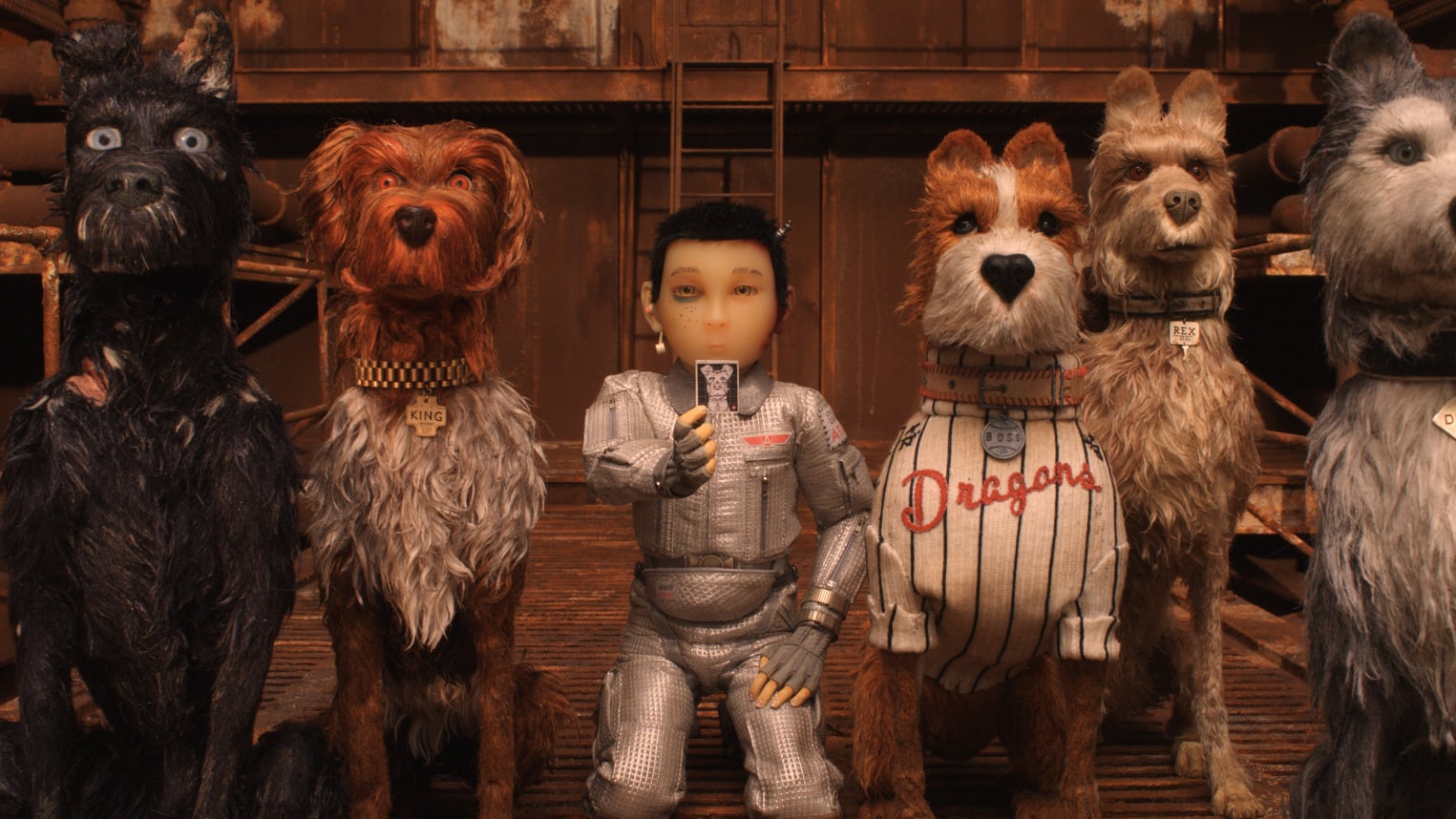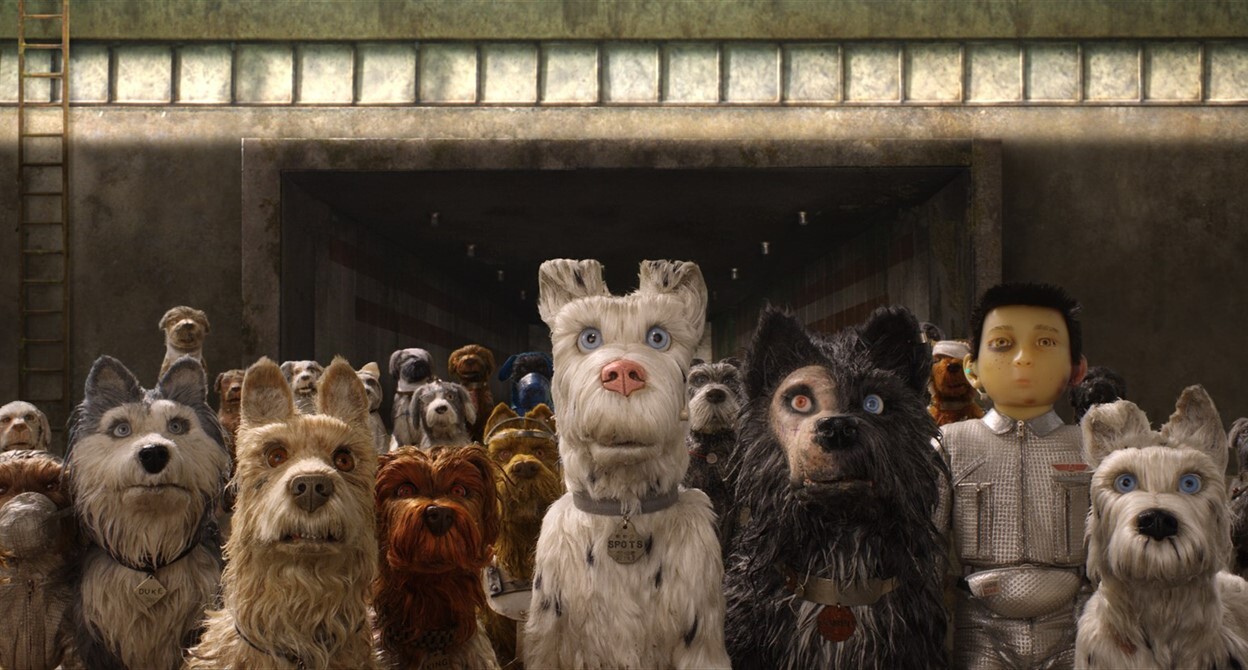Oh, Wes Anderson, what is it about you and your movies that make us fall in love with them? Is it the peacock of your bright, vibrant colour palettes that catches our eye? Perhaps it’s the hipster schoolboy whimsy, the likes of Luna Lovegood, that make our hearts flutter? Or the fact that your shots are just so damn symmetrical? For me at least, it’s all of the above and more. Anderson has always struck me as both painter and storyteller. He uses strong visual imagery and smart camerawork to guide the audience through a journey of the joys and foibles of the human condition.
Whether it’s the subject of existentialism and pride in the fun, heistful Fantastic Mr Fox or growing pains of childhood and sexuality in the melancholic Moonrise Kingdom, there’s always a wider picture to be found in his gorgeous looking films. As for his latest one, Isle of Dogs, the same can be said here. This is by far one of his more ambitious films. His signature deadpan humour and aesthetic eye is back in this claymated comedy-drama about a young Japanese boy’s search for his lost dog and an old dog’s quest for a home. It was charming, hilarious, heartwarming and just so MUCH WHIMSY!
I loved following Chief’s journey from stray with a chip on his shoulder to loyal, brave friend of man. The whole cast was on point, both English and Japanese. And to see him take the film to such a foreign and unique setting, in comparison to his more Eurocentric and Americana film locales, made the experience all the more interesting. For others, however, his little tour through the land of the rising sun was met with less than enthusiastic responses…
Enjoyed Isle of Dogs, but man that cultural appropriation/disrespect https://t.co/zNx9DKkiyq and female representation https://t.co/S39eX4LOfp … I should probably just stop seeing Wes Anderson movies.
— (BLM) Sean Barrett (@nothings) April 8, 2018
Isle of Dogs is being accused of cultural appropriation and even being offensive towards those of Asian descent. The spectrum of criticism on the film is varied. On the milder end, LA Times writer Justin Chang’s comments on the insensitive nature of the way Anderson depicts the Japanese people’s linguistic agency and the discrepancy between the use of the English and Japanese language. Way over there, however, critics like Slant writer, Steve McFarlane and Under The Radar’s Trunick have found the film to be a “failure” due to its lack of politically correct treatment of the subject and even leaves “a mildly gross, Orientalist aftertaste in some viewers’ mouths”. And let’s not even mention how twitter and reddit poured gasoline on this already contentious matter. However some have come in defense of the film like The New Yorker writer Moeko Fuiji who supported the director’s decision and argued that the film empowered the native Japanese audience. Cultural appropriation in the most general, unpolitical sense can be defined as borrowing elements and aspects of a different culture and placing them in a foreign, and often accused of a western imperialistic, setting.

For me, there’s no debate here that Mr Anderson certainly appropriate certain aspects of Japanese culture in his very prettily animated American film. And the act by itself isn’t necessarily heinous because in an age of increasing globalization, it’s bound to happen. If you want to fully eradicate it, you’ll have to clam down on films like Shahrukh Khan’s Kal Ho Naa Ho, a Bollywood film that uses the backdrop of New York as a cultural novelty or the countless animes who made exaggerated parodies of the west. And though one might argue about that there are certain histories of colonial imperialism and oppression that makes the West a dominant force in a sense, I say it’s the 21st century and we’ve learned to have a better idea of our shared humanity. Get over it. So the question here isn’t about whether Anderson committed appropriation but rather whether he did it well? That’s what we’re here to find out so put on your sociological thinking caps and let’s dive into Isle of Dogs!
The Oriental Landscape

One thing to keep in mind is that while Anderson utilizes established motifs and cultural fixtures, he’s painting his own rendition of what he thinks the land is. In a sense, the author is setting his own fictional landscape of Japan, weaving elements of native myths, real world facts and national history to create a fictionalized Japan. The beginning of the film is the auteur’s own feudal era legend of a cruel feline-loving daimyo who launches a campaign to end the existence of dogs. His only opposition being a brave boy samurai who fights on behalf of the dogs’ survival. The man has even claimed to have taken inspiration from Akira Kurosawa, who is well known for his films set in the feudal era of Japan like Seven Samurai. The architecture of the film is rather reminiscent of modern Japan. And beyond the occasional mecha-dog, Anderson refrains from caricaturing Japan as a Shogun-boy fantasyland or hyper-futuristic metropolis.

Okay, that’s all well and dandy but what about the treatment of animals in this film? Surely this is perpetuating a negative stereotype of Asians as uneducated, dog-hating barbarians? For that, I have three things to say. Firstly, Anderson didn’t just make up the idea of animal oversaturated islands. He was inspired by real life parallels. Islands like Honshu which have higher cat density to human and Okunoshima, a bunny infested landmass, are very real-life examples. Secondly, during World War 2, the Japanese did use the local rabbit population of Okunoshima as test subjects for poison gas. So much so that American military chose to euthanize the infected rabbits to prevent further environmental problems. In the film, the dogs of trash island are used as test subjects of cruel experiments and must bear the consequences of the Japanese industrial complex.
But Anderson doesn’t necessarily hold the whole of the Japanese people accountable for these atrocities which brings me to the next point. Finally, not all Japanese people in the film share the anti-dog sentiment. There are plenty of Japanese characters besides the plucky Atari Kobayashi who fights against this injustice. Furthermore, the hatred of dogs in this film isn’t played up as some innate cultural hysteria that the Japanese public shares. Rather, it is the agenda of a minority group that coerced the masses into supporting the canine-flu legislature. Anderson isn’t putting Japan on trial here, if anything he’s attacking a very common strain of neoconservatism.
It’s safe to say that Anderson has certainly done his homework here. So while the narrative of a privileged white artist using his film as a form of cultural warfare on the East is a spicy one, that isn’t quite entirely true is it? The reality of Isle of Dogs is both fictional and real, the same way the film is both full of light-hearted fun as it is also grounded in a complicated reality. No country is perfect and its mistake shouldn’t be hidden away nor should it be paraded for humiliation. Here Anderson does neither, rather he acknowledges the flaws of a nation thoroughly, presents its virtues respectfully and articulates a possible hope realistically.
Tackling Translation
A quirk that you might notice in this film is that Anderson has decided not to include subtitles in this film but rather Japanese characters are left to speak their native tongue and mind when not being translated. This right here I’ll admit is a bit of a double-edged sword. Those fluent in the language or of the descent like Emily Yoshida or the earlier Fuiji found very little problem with the actual spoken dialogue. They sound just like regular folks, none of them were going on about honour, katannas or waxing poetic about times long past (except maybe for the occasional haiku). For the most part, they spoke like normal human beings albeit caught in extraordinary circumstances. So perhaps there’s no particular problem with the writing or script itself but the delivery on the hand is a subject that must be understood in isolation.

As a banana (slang for Asian person who speaks predominantly English), I had to place myself in the same shoes as an average American watching this. I’m sure I didn’t know anything more than Bob from Wyoming about Japan, besides the usual stereotypes that come to mind. Therefore, from what I observed, at times the dialogue can be hard to hear or even be muffled sometimes.
This is often followed up by a clearer translation from the talking canines or the translator in the film. And even when it’s not translated, the delivery is so animated and even borderline manic to the point that anyone could have guessed what the characters were saying. One scene in particular that I found myself chuckling at was when the Palpatine looking Major Domo angrily scolded Atari for patting his guard dog. And while the dialogue itself isn’t anything ridiculous, it was clear that the humour in that scene was purposely derived from the alienness of the language for a foreign audience. I’ll concede that it can be interpreted as a tad bit condescending.
Scenes like that, however, are rare and far between in the film, most of the time the dialogue is fluid and the pronunciation clear. Major Domo is a cartoonish villain in the film, but there’s nothing particularly representative of the wider Japanese community in him beyond the language. To be fair though, the film does quite often have the dogs speaking English and their ineptitude at understanding their very masters’ words is often played up for laughs. I’m not saying that self-flagellating jokes make up for offensive ones, like some sort of strange tit-for-tat. Rather there is a sense of fair play in comedy. What separates an insightful comedy from being mean-spirited is its ability to poke fun at everyone and ultimately have all sides reflect on their similarities and differences. Here the punchline is language barriers and Anderson goes for the kicker all around.
Let’s Talk About Tracy

Right, time to address the very white elephant in the room: Tracy Walker. Certain people like Angie Han see Tracy’s involvement in the film as Anderson playing out the white saviour trope. An enlightened westerner travelling to a foreign land to correct the locals of their mistake. I didn’t really see that however, in fact, I saw the opposite. Anderson’s depiction of Tracy is a sort parody of the idea of the white saviour that justifies her awkward position in a foreign land under the veil of a neoliberal agenda. Moreover, Atari is the main hero of the story and she wouldn’t really have been motivated to investigate further if it wasn’t for him making such a political scene. She isn’t really the catalyst of the plot so much as she is an active participant in the events happening around her. So to call her a white saviour is not only a bit of a stretch but to also miss the punchline here.

Tracy Walker is a sort of reflection of foreign infantasizement that the West has with eastern and Asian culture. Her involvement in the community of Japan does not undermine the greater narrative at play but rather adds an interesting perspective to it. A fish out of water fighting with an already existing national opposition for a cause she believes in. At the end of the day, she doesn’t get a lot of screen time anyway and besides her slightly annoying, preachy tone, she isn’t exactly offensive. Just a walking critique that’s a little too obvious, Anderson.
Isle of Dogs is a film of contrast and harmony, with myths of old and modern woes, English dogs and eastern owners but at the end, their differences are reconciled and balance is reached. While in reality, life is never that simple, it’s an important fact that critic and fan should both acknowledge. Wes Anderson’s Isle of Dogs isn’t perfect but based on the evidence there’s little to be offended over. Cultural appropriation is a part of this wider and more connected world. So while we cannot effectively stop the possibility of offensive products being created from it, we should continue to see how filmmakers and artists can refine the process. Some days we’ll get crap and other days we get Isle of Dogs.







